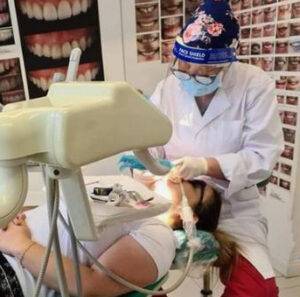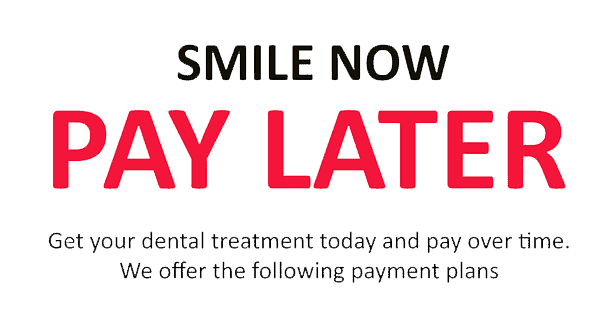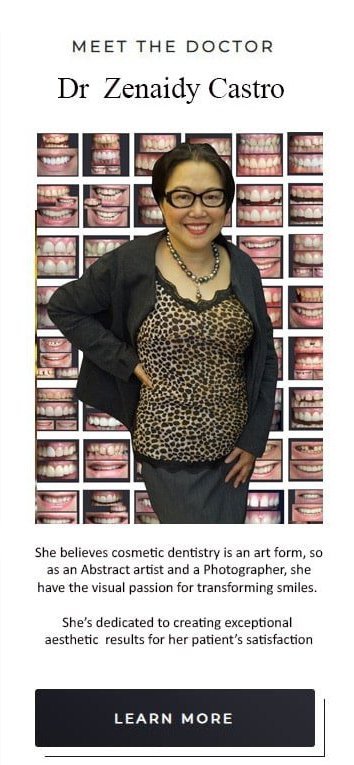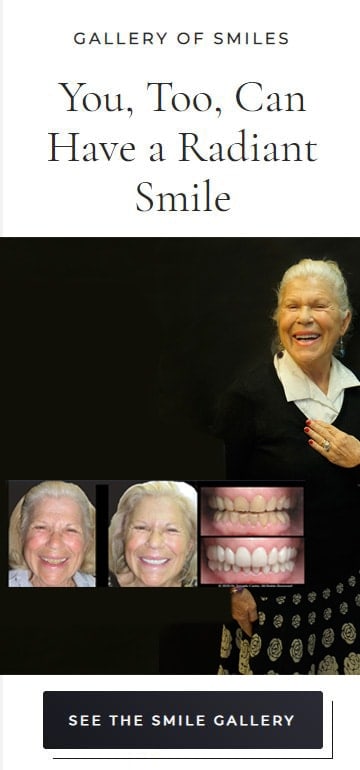Your ultimate Guide on how to Fix and Repair Chipped tooth, Cracked & Broken Tooth
Broken, cracked & chipped teeth can as embarrassing as they are painful. Learn about your alternatives & the procedures used to repair or replace damaged tooth.
Read more below.
Chipped tooth Melbourne, Cracked tooth Melbourne & Broken Tooth treatment
Unpopped kernels of popcorn Rough sports Chewing on ice or hard candy Eating nuts Biting down on forks & other utensils Using your teeth as a prying tool Accidents or trauma to the face Teeth are very strong but they are not indestructible and the above are only some ways that you can damage them. Another less obvious cause is cavities that will weaken your teeth and then can lead to a broken one.
An accident or some other trauma will probably show up as a loose piece of tooth in your mouth which is often followed by sharp pain. This pain is caused from the nerve being exposed to air, saliva or hot/cold food or drinks.
Other symptoms of broken teeth can be very subtle such as minor fractures or cracks that don’t always hurt but if they do, it can be extremely hard to find out which tooth is hurting. These can also be symptoms of chipped teeth which sometimes can be seen but sometimes are not seen just by looking at your teeth and they may not even be seen with an X-ray so following is a list of symptoms to watch for:
Sensitivity to extreme temperatures Sensitivity to sour or sticky food Mouth pain while chewing Sudden shooting pain Irritation on tongue or cheek due to a rough or sharp-edged tooth And sometimes it will take a variety of clinical aids, including X-rays, surface bite devices or cold water applications to find the broken tooth.
If you have a Chipped tooth, Cracked & Broken Tooth either in the front or back of your mouth, you will probably want to have it repaired not only for health reasons but for cosmetic reasons also. So following are some ways to treat chipped teeth and some ways to treat broken teeth and our dentists will know what way is best for you.
If you chip your tooth, you aren’t likely to feel any immediate pain, especially if you only chip a small part. A cracked tooth also doesn’t feel bothersome, except when you eat something too cold or too hot and the nerves in your tooth’s inner layers are exposed.
But just because you don’t feel any pain doesn’t mean you should let your cracked or chipped tooth go unchecked. If you neglect having a check up, you might suffer from the following:
You could cut your tongue A chipped tooth may have a jagged, sharp surface or edge. If you ignore it, that side of your chipped tooth might cut your tongue or cheeks, causing unnecessary and completely avoidable pain.
Your tooth becomes sensitive to pressure Another common cause of a cracked or chipped tooth is cavities. Cavities weaken the teeth, compromising their strength. Moreover, decay diminishes a tooth’s density, leaving it more susceptible to pain and sensitivity as well as to breaking under the slightest bit of pressure.
Your tooth becomes sensitive to temperature When you tooth cracks or chips, the nerves or the root may become exposed. These internal parts of a tooth are extremely sensitive to temperature. As a result, when you eat or drink something too hot or too cold, you may experience severe, shooting pain in that tooth, making it difficult for you to enjoy your food or drink.
Your teeth and gums may become infected If the inner structure of your tooth gets exposed from a crack or chip, that tooth becomes more vulnerable to infections. Bacteria can easily invade the dental pulp—the innermost part of the tooth containing blood vessels and nerves. Once this happens, the bacterial infection forms a pocket of pus called a tooth abscess.
As you can see, a cracked or chipped tooth may seem like a simple dental problem that you can just ignore. But, left untreated, one cracked tooth can cause severe pain and complications down the line.
The outer layer of the teeth is remarkably strong, but once it gets chipped, broken or otherwise fractured, the inner layer becomes readily exposed to all kinds of problems. It is also the time when the discomfort and pain level is highly excruciating.
Minor chipping often goes unnoticed, but when a large part of the tooth gets broken, this can hurt the nerve of the tooth and can become extremely sensitive to cold and hot temperatures. Dental Procedures to Repair Your Chipped, Cracked or Broken Tooth
Chipping or cracking a tooth accounts for the majority of dental injuries we see in our office. However the injury occurred, don’t worry, your smile and your teeth can be repaired. But it’s important to fix a chipped or broken tooth as soon as it occurs to ensure it doesn’t cause additional problems and increase costs down the road.
As a dentist, we categories broken teeth in these ways .
These are small vertical cracks in your teeth that can be caused by things like chewing on ice or even an imbalanced bite. Craze lines are technically tiny cracks in your teeth, but they are not a major cause for concern.
When a portion of a tooth’s chewing surface breaks off, usually around a filling, it’s known as a fractured cusp. It typically doesn’t cause much pain and rarely damages the pulp.
When a crack stretches from the chewing surface vertically toward the root, we refer to this as a cracked tooth. If left untreated it usually results in tooth loss.
A split tooth is what happens if you leave a cracked tooth untreated. Like a cracked tooth there is a crack, but it is split into two pieces by a crack that runs through the tooth.
This type of fracture is the worse case scenario and occurs when a tooth breaks straight down the root. Often it splits down the middle just like a piece of firewood.
If damage to the tooth is extensive, like a broken in half tooth that exposes nerves and blood vessels in the pulp, a root canal or extraction might be necessary. This is largely isolated to incidents where the root is damaged or there is a significant amount of infection.
If your tooth cracks in half, call your dental office immediately to set up an appointment. Make sure to let them know, your tooth is cracked in half. A broken tooth is not something you should put off. It could get worse and become infected. The infection would start in the tooth’s pulp and then spread to the gum and the bone beneath your tooth. If you can’t see your dental professional right away, continue your usual oral hygiene routine until your visit. Just use extra care and brush the cracked tooth more gently.
A broken tooth often warrants a visit to an emergency dental office. In fact, tooth fractures are one of the most common dental emergencies.
However, emergency dental care is needed for major tooth fractures. A serious fracture is one where a large chunk of the tooth is gone. This condition is often accompanied by intense dental pain. Under these circumstances, seeking immediate medical attention is crucial.
Does a broken tooth require an emergency dental visit? The answer to that question is not always a clear-cut answer. It depends on the severity of the fracture. For instance, minor chips can wait for a regularly scheduled appointment. However, seek medical attention immediately if a major portion of the tooth is broken. In many cases, a dentist can work emergencies into the schedule at a moment’s notice.
An untreated Chipped, broken or cracked tooth can lead to tooth sensitivity, tooth decay, and ultimately tooth loss. If you’ve cracked a tooth, it’s important to make an appointment to see us as soon as you can so that it can be evaluated and treated if necessary.
A cracked tooth can vary in its severity. It may be a small and shallow crack or it could be deeper towards the root and/or nerve. A dentist will evaluate the potential crack by looking for the crack, making gum measurements around the tooth, taking an X-ray, and possibly testing the status of the nerve or if there is pain when biting.
Nothing will happen. The tooth could chip- simple repair. Or it could crack and would need a crown. In rare cases waiting could cause a root canal to be needed. The tooth could split, which could require crown lengthening or extraction. These are things that your dentist should be prepared to talk over with you.
Your dentist will recommend a treatment for your cracked tooth based on how minor or major the crack is. There are four types of treatment options available to you so that you can repair your front cracked tooth:
Dental bonding. A material called composite resin is commonly used for repairing teeth that have been damaged, especially if the damaged portion is relatively small and noticeable. This material is applied to the tooth to cover the crack and reshape the tooth to look like a natural repair. Porcelain veneers. Sometimes, bonding a porcelain veneer over the front of the tooth is a relatively easy and long-lasting solution to chips and cracks that are just superficial and aesthetic in nature. Veneers can last ten years or longer with proper care. Dental crown. More substantial cracks and chips may need a crown to bond over the tooth to add an extra layer of protection to damaged teeth. These porcelain restorations look completely natural after being custom-made and cemented in place. Root canal therapy. If the crack or chip reaches the inner portion of the tooth canals, it can result in an infection of the dental pulp inside. The best treatment for this situation is root canal therapy, which addresses the infection while maintaining the tooth in the smile. Tooth replacement. If the chip or crack is extremely large, patients may need to have the tooth extracted and work with their dentist to determine the most appropriate tooth replacement option, including dentures, bridges, or dental implants.
The quicker you can get into your dental professional for evaluation, the better. It could ultimately save your tooth. Your dentist will then be able to take a look at the damage and decide the best treatment for saving your tooth. Here are some of the treatment options available
• If a tiny piece of enamel or filling has chipped off, you may only need a new filling or some bonding material to restore the chipped portion.
• If only a small piece of your tooth broke off, your dental professional might be able to protect the remainder of the tooth with a crown or filling
• If the fracture is severe, endodontic surgery may be required to remove the fractured portion to protect the pulp and the tooth
• If the crack extends down into the pulp, you may need a root canal or tooth extraction
If a tooth is cracked, it is a serious condition and does usually require a crown. Unlike a broken bone, the fracture in a cracked tooth will not heal.
Vertical cracks that travel to the gumline may require a full-coverage crown. If the crack goes below the gumline, the tooth may require a root canal, with crown lengthening or possibly even extraction.
In some cases, while a crown is one option, there can be others. You might opt for a filling instead. Keep in mind, however, that a filling does not prevent you from needing a crown later on. Also, if a substantial portion of your tooth needs filling, a better solution is usually the crown because fillings do not give you the same kind of protection as crowns do. Also, if the filling is extremely large, it can cause the tooth to break, making it irreparable.
Depending on the severity of the damage, and any new or pre-existing damage in the surrounding area, the fix will range from a simple filling, to a more involved process like placement of Porcelain Veneers or Dental Crowns.
If you’ve only chipped off a small piece of tooth enamel, you may be a good candidate for one of the simplest forms of cosmetic dentistry, dental filling or bonding.
Bonding filling . The composite resin is bonded to the tooth to fill the chip or crack and to protect the surrounding tooth structure. But for more severe cases of cracks or chips, dental veneers may be the more appropriate way to go.
Porcelain veneers
In comparison to crowns, which we’ll discuss shortly, porcelain veneers cover only the front side of a tooth.
Dental Crowns
If your tooth is severely chipped, a dental crown has the unique ability to fit snugly and safely over the tooth you don’t like, while the outside of the crown is shaped and colored to match the rest of your smile.
Dental crowns are a form of cosmetic dentistry that is recommended when working on top of the existing enamel (if any) isn’t an option. With a chipped tooth or teeth, this may be desirable particularly if there is weakness or structural damage in addition to the visibly chipped tooth or teeth.
Because enamel doesn’t grow back and won’t heal on its own, if your tooth is badly cracked in addition to the chip, and at risk of falling to pieces, a custom-fit crown could be the way to go.
Your dentist will take a number of factors into account when deciding whether your teeth would best be served with either porcelain veneers or traditional crowns.
The main factor is how severely chipped, broken or cracked your tooth is.
The condition of your gums, what type of bite or occlusion you have as well as the amount of damage the teeth have suffered are all taken into our consideration when determining the best method to restore your teeth. Porcelain veneers rely on intact enamel for their bond strength and sometimes there won’t be enough quality enamel for veneers, but with modern crowns made of porcelain, it is difficult to distinguish whether they are porcelain veneers or caps.
Cost is another consideration for the patient. Porcelain veneers, since they only cover the visible side of the tooth are usually considered to be cosmetic in nature and may not be covered by insurance, even though the procedure for veneers and crowns are nearly identical and the costs usually very close.
You and your dentist can discuss the pros and cons of each of these products to find the one that will best suit your pocketbook and your needs. As a dentist, I know that all dental professionals are more than happy to take the time to discuss the proper procedures that will have you smiling again, but it is up to you to ask the right questions that will elicit the information you need to make your decision.
To possibly save your tooth, avoid more damage and potential infection, it’s important to see your dentist right away. If you have a chipped or broken tooth , call our office right away. If you have been putting it off, call our office today to schedule an appointment.
The cost of treatment varies depending on the severity of the break, whether it’s a front tooth or molar, what type of dental procedure is used to repair it, and other factors like insurance coverage, location, and the dental office’s pricing.
Here’s what you should expect to pay to repair a chipped tooth (without insurance):
Procedure Cost Per Tooth Filling $90 to $500 Dental Bonding $300 to $700 Dental Crown $500 to $2500 Root Canal Therapy $900 to $2200 Dental Onlay $650 to $1,200 Dental Veneer $700 to $2,500
Dental insurance may cover some or all of the procedure costs. The most significant factor is whether your insurance plan considers the procedure necessary or cosmetic. Veneers and implants are often deemed cosmetic or elective procedures, while most other chipped tooth treatments are considered medically necessary.
Lost tooth Filling, Filling Fell Out of Tooth, Filling Falls Out Lost tooth Filling, Filling Fell Out of Tooth, Filling Falls Out BPA Free Composite White Fillings
Porcelain Tooth Inlay and Onlay – Ceramic Tooth Fillings
Replace Silver fillings with White, Composite Fillings
Tooth Filling in Melbourne CBD – Treat Cavities & Decay FAQ
Dental Fillings Melbourne CBD – Types and Cost of Fillings
CALL US NOW 9629-7664 to Fix and Repair you Chipped tooth, Cracked & Broken Tooth
Lost tooth Filling, Filling Fell Out of Tooth, Filling Falls Out
Affordable General Dentistry in Melbourne with Payment Plans We offer our patient with easy and affordable way to budget and pay for their dental treatment
With dental payment plan, you can spread the cost of your treatment into affordable payments and get that winning smile and a healthy pain and problem free smile. The payment plan enables our patients begin with their treatment immediately – then pay the cost of their treatment spread over time. It is an excellent payment option for elective cosmetic and/or emergency or general dental procedures.
We have different third party financing company who would love to help you get the treatment that you need.
Best Dentist in Melbourne CBD-Best Dental Clinic in Melbourne Learn more about our dental financing option
Get the Dental treatment that you need from $25 per week with TLC payment plan














